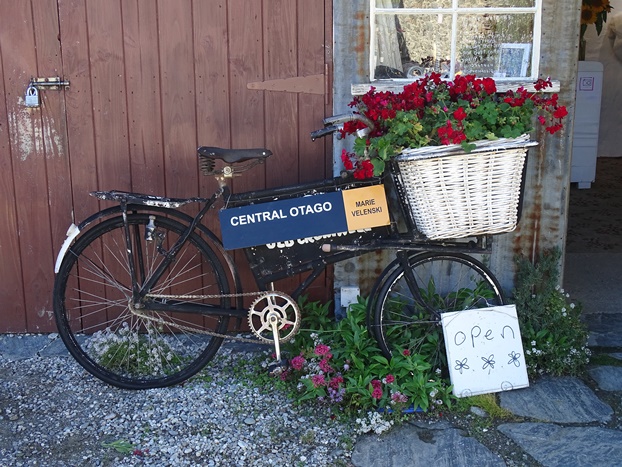Cromwell is a town in Central Otago situated on the southern edge of Lake Dunstan where the Clutha and the Kawarau Rivers meet. In 1862, gold was discovered in this area and Cromwell, then called The Junction, developed as a result of this. Today it is more well known for the fruit the area produces, such as apricots, nectarines and peaches.
On the shore of the lake in Cromwell is the Cromwell Heritage Precinct. This area has been set aside as a reminder of the past. Many old buildings have been retained as original. Within them, some have been treated as a museum, with models, machinery and items dating back to the 1800s, whereas other buildings are now art and craft shops, cafes, offices, etc. The exterior of the shops have retained their original facade—what is inside, however, differs.
This board near the entrance shows a map of the area and lists the old name of each building beside the name of the business it now houses.
Entering the precinct. There is no charge to look around. This building, once a bakery, is now an art gallery.
Wisharts Blacksmith
Lake Dunstan is a man-made lake formed by the construction of the Clyde Dam. Parts of the town of Cromwell were relocated before they flooded the area in 1992 - 93.
This picture shows what the Athenaeum Hall once looked like. You can see it's now partially buried, with the two pictures at bottom right showing the tops of window frames at the level of the road.
The office of the Cromwell Argus (local paper), with a scary looking man behind the desk.
There were old printing machines . . .
. . . and even old telephone exchange boards!
A beautiful old barn . . .
. . . with this amazing stone floor.
Many of the buildings were made of stone. The floors in this stable were also stone. They weren't very easy to walk on. I imagine it would have been slippery for the horses too.
The old Post & Telegraph Office now houses a modern set of offices.
Leaving the precinct, as we drove down the road, we came across this beautiful old church—The Stone Temple. The signs tells how it was formerly known as St Johns Presbyterian Church and was built between 1880 and 1881. In 2004 it was sold to new owners who restored it to a modern home. It's now available as boutique accommodation and also used as a wedding and event venue
At The Junction Lookout further down the road, there are views of where the rivers meet. There's an excellent sign pointing out all the landmarks.
And immediately across the lake lie rugged hills.
If you cannot see "Post a Comment" below, click here (and scroll down to the bottom of the post) to talk to me!























No comments:
Post a Comment
Comments are very much appreciated. Thanks for taking the time to do so.